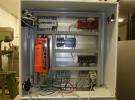Hello,
I'm reading AIN0 and AIN1 using an externally clocked stream. The range of both channels is set to +-10V. STREAM_SETTLING_US is set to 0.
I'm getting quite a lot of noise:
- Resolution index = 3, noise around +-20mV
- Resolution index = 0, noise around +-50mV
This noise is just an estimation by looking at the attached picture. Vertical axis is volts.
By looking at https://labjack.com/support/datasheets/t-series/appendix-a-3-2-2-t7-noise-and-resolution I see that the resolution for the resolution index 3 and 0 should be 0.158 and 0.316mV.
I'm having some difficulties understanding what is happening. What I would expect is that if let's say my signal has 20mV noise with resolution index 3, it should have 20.158mV noise at index 0.
Is this normal or have I missed something ?



.png%3Fitok=PHGBxf6M)


.jpg%3Fitok=B1YcuDFK)
.png%3Fitok=Ybt-OlgU)
It is difficult to characterize the noise due to our hardware while using an external signal with its own noise sources. To test the noise on the AIN we recommend sampling an AIN tied to GND and taking the standard deviation of all resulting samples. We have some other tests described in this app note: https://labjack.com/support/app-notes/test-AIN
Resolution indexes above 1 utilize oversampling and averaging of ADC samples to reduce noise and improve the effective resolution of the AIN, so that is also likely reducing the noise from your signal.
Thanks for your reply. All this makes a lot more sense to me now. The oversampling does not only reduce the LabJack noise, but also the signal noise by doing an averaging over a longer period of time.
So I guess I'll work on reducing the noise on the signal before it reaches the LabJack by checking the wiring and maybe adding a filter. The LabJack noise is most probably not an issue here.
To clarify, ResolutionIndex 1-8 use oversampling & averaging to provide noise reduction and increased effective resolution. ResolutionIndex 9-12, on the T7-Pro, use the Output Data Rate and FS settings of the AD7190 sigma-delta converter to control the tradeoff between noise and sample time.
For the +/-10V range, Table A.3.1.1 shows an effective resolution of 316 uV at ResIndex=1 (0 equates to 1 in stream mode) and 158 uV at ResIndex=3. The text on that page tells you that "effective", aka RMS, means 1 standard deviation and thus most of the readings will be in this noise band. If you connect a low noise signal, such as a jumper to GND, you should see similar results to Table A.3.1.1.
You noted that when you stream your signal at ResIndex=1, you see a noise band of about 100 mV. Since there is no oversampling at ResIndex=1, and 100 mV is substantially more than 316 uV, you know that 100 mV is the noise level of your signal itself and the inherent T7 noise is negligable in this case.
From Table A.3.1.1 we see that changing from ResIndex 1 to 3 results in half as much noise. It is fair to say that if a signal has random/white noise, that noise will also be reduced about half by moving from ResIndex 1 to 3. In your case you saw a reduction of a little more than half, but in line with that thinking.
You are definitely on the right path to investigate your noise before you hide it. Often people will simply try to hide noise with a hardware filter or increased ResIndex, but that is usually only a good idea if the noise is expected for some reason. Consider that the noise could be a sign that there is a fundamental problem with your signal / connections that should be addressed.
Thanks a lot for these explanations. In my case the noise might very well come from GND that is not wired in the best way.